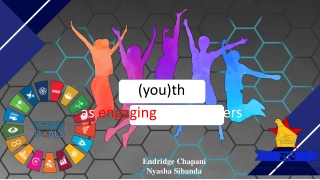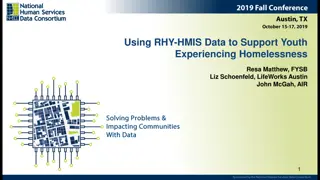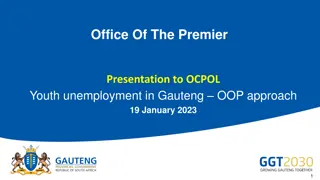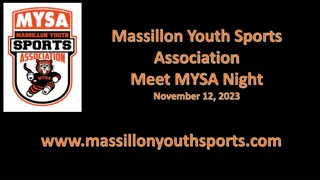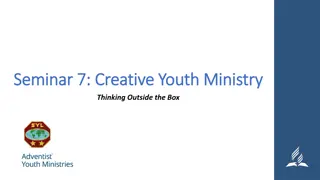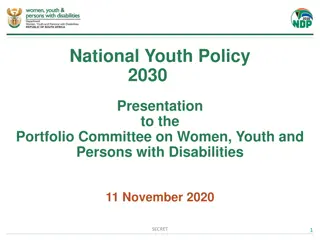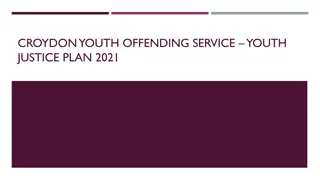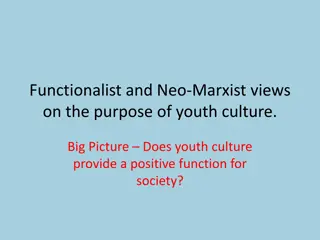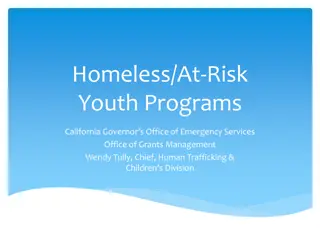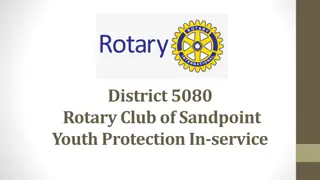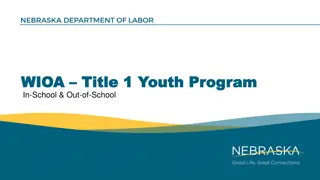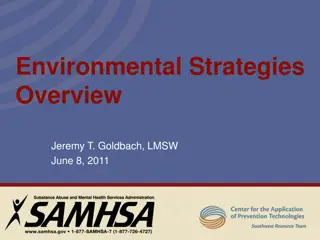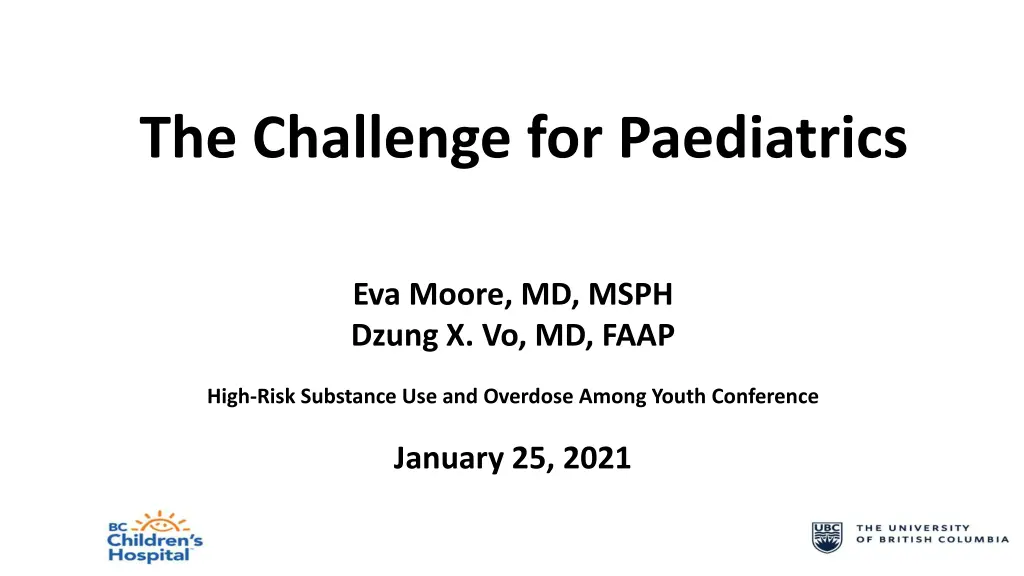
Challenges in Adolescent Substance Use and Treatment Decision-Making
Explore key topics related to adolescent substance use, neurobiology of addiction, authoritative parenting, adolescent assent and dissent, and consent under the BC Infants Act. Gain insights into high-risk substance use among youth and the complexities of treatment decision-making in pediatric care. Learn about the impact of evolving adolescent brains, authoritative parenting styles, and legal considerations for minors' consent in healthcare settings.
Download Presentation

Please find below an Image/Link to download the presentation.
The content on the website is provided AS IS for your information and personal use only. It may not be sold, licensed, or shared on other websites without obtaining consent from the author. If you encounter any issues during the download, it is possible that the publisher has removed the file from their server.
You are allowed to download the files provided on this website for personal or commercial use, subject to the condition that they are used lawfully. All files are the property of their respective owners.
The content on the website is provided AS IS for your information and personal use only. It may not be sold, licensed, or shared on other websites without obtaining consent from the author.
E N D
Presentation Transcript
The Challenge for Paediatrics Eva Moore, MD, MSPH Dzung X. Vo, MD, FAAP High-Risk Substance Use and Overdose Among Youth Conference January 25, 2021
Neurobiology of Substance Use, Misuse and Addiction The Surgeon General s Report on Alcohol, Drugs, and Health. Washington, DC: HHS, November 2016 Addiction Cycle Evolving adolescent brain is particularly vulnerable
Authoritative Parenting I love you. I m not your friend, I m your parent, and that s even better. I ll let you make your share of mistakes, but for the things that might affect your safety or morality, you ll do as I say. Warm and responsive (unlike authoritarian parenting) Set firm rules and boundaries (unlike permissive parenting) Ginsburg KR. Raising Kids to Thrive. American Academy of Pediatrics, 2015 Center for Parent & Teen Communication: https://parentandteen.com/
Adolescent Assent and Dissent When risks are minimal and the benefits of a proposed therapy are clear, for example, when considering treatment for a local infection, a 14-year- old may have sufficient capacity to understand and consent. But when refusing experimental chemotherapy, the same patient might not have the capacity to reason through the complex issues involved. If the youth is deemed capable and requirements for informed consent are met, authorization of treatment by an SDM is not legally required. When an adolescent s capacity is less certain, invoking the family-centred, shared decision-making model described above may be appropriate. Coughlin KW. Canadian Paediatric Society Position Statement: Medical decision-making in paediatrics: Infancy to adolescence. Paediatrics & Child Health. 2018;138-146.
Consent: BC Infants Act Infants (age < 19) can consent to their health care if the provider has: Explained to the infant and has been satisfied that the infant understands the nature and consequences and the reasonably foreseeable benefits and risks of the health care (CAPACITY) Has made reasonable efforts to determine and has concluded that the health care is in the infant s best interests. (BEST INTEREST) ? Does not apply to capacity for REFUSAL CPSBC: https://www.cpsbc.ca/files/pdf/LG-Consent-of-Minors-Infants-Act.pdf
She tried to get the hospital to admit him for treatment, she says, but doctors just revived him and sent him home with his mom. http://globe2go.newspaperdirect.com/epaper/viewer.aspx?noredirect=true
Stabilization Care: What it Looks Like Immediate stabilization in Emergency; engage guardians Admission: Pediatrics Ward Psychiatry: Consult-Liaison, Concurrent Disorders Robust community involvement for case management and discharge planning Leadership: BCCH Steering Committee & Working Groups
Pediatric Specific Challenges Guardianship, confidentiality Working in a children s hospital environment Lack of EBM in pediatrics Medication guidelines for pediatrics Developmental: Age, FASD, ID
BC Mental Health Act? The person has a disorder of the mind .which seriously impairs the person s ability to react appropriately to his/her environment or to associate with others. The person requires treatment in or through a designated facility. The person requires care...to prevent his/her substantial mental or physical deterioration or for the protection of the person or for the protection of others. The person cannot be suitably admitted as a voluntary patient.
MHA Certification: Parallels from Youth with Eating Disorders Often low insight or readiness to change Families often desperate for help Best practice at BCCH to certify adolescents for severe eating disorder when: Life at risk due to medical instability, and/or Extremely sick + Failure of outpatient management Does not require psychosis or suicidality Certifications frequently reviewed; rarely overturned by review panel Coercive measures often viewed as life-saving in retrospect
Case: 14 year old female with FASD* 14y female w/ FASD, ADHD, LD, anxiety, depression, h/o behavioral dysregulation. Multiple previous admissions to acute psychiatry since childhood. In MCFD care, group home. Complex relationship w/ biological mother. Strengths: Charismatic. Humor. Loves his mother. Sports. Dysregulations improving @ group home. *De-Identified, composite case
Case: 14 year old female with FASD* BCCH ED presentation: Opioid overdose. Naloxone in field (bystander). Taken by VPD to ED, voluntarily, early morning hours. 4th OD in one month. Irritable. GI sx s. PO Hydromorphone x1. Refused subsequent meds. Wants to leave. ED Management? Disposition?
Case: 14 year old female with FASD* Week post BCCH ED presentation: No-show to appointments. Day 4: 2nd BCCH ED presentation, OD methamphetamines, heroin Found by VPD with decreased LOC -> called EMS En route to ED: Convulsive activity. Received Ativan, naloxone x1. GCS 3 10 Now what?
Case: 14 year old female with FASD* Certified in ED Initially PICU -> Ward Buprenorphine-Nalaxone rapid induction Buprenorphine ER injection requiring sedation (nitrous oxide) Voluntary transfer to treatment facility Ambivalent about OAT; further treatment Recommendations for ongoing management?
15 year old female in MCFD care 15 y/o with polysubstance use, DOC alcohol History of depression, suicide attempts, sexual abuse. Removed from family due to parental substance use; went with siblings to foster family, but foster family unable to care for her due to behavior (leaving the house, defiant), sent to group home Multiple ED visits: suicidal, intoxication In past week, has had escalating substance use with fentanyl, leading to overdoses reversed by friends, EMS During intoxication, sexually exploited by older males on repeat occasions *De-Identified, composite case
Case 2 continued Youth reports he intended to drink but then agrees to use other substances & risk activities while intoxicated Care team meeting: guardian, primary care provider, counselor, PO officer Questions raised: How do we break the trajectory? How do we keep her safe sexually? How much buy-in is needed from the youth vs how much do we insist on a plan? What developmental or neurodevelopmental challenges are at play here? What is our recommendation to probations? Should we push for conditions that support mandated treatment? How do we support human connections if they are constantly moved from one house to another, and when family is also suffering with addiction? How do we support one another emotionally when faced with so much tragedy?


